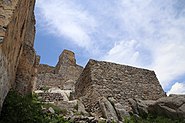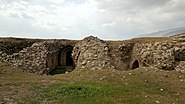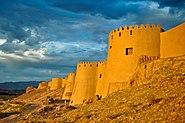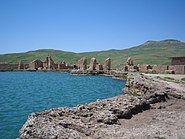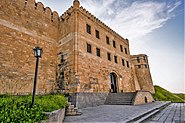Great Kyz Kala
| Great Kyz Kala | |
|---|---|
 The Great Kyz Kala.[1] | |
| General information | |
| Type | Castle |
| Architectural style | Sasanian |
| Town or city | Merv |
| Country | Turkmenistan |
| Coordinates | 37°39′18.18″N 62°09′09.21″E / 37.6550500°N 62.1525583°E |
The Great Kyz Kala is a large fortress in the ancient city of Merv, now in Turkmenistan.[1] The fortress belongs to the köshk or kushk type: an earthen building built on a raised platform, with exterior wall formed of large vertical engaged columns (a series of octagonal half-columns) having the aspect of large corrugations.[2][3] These fortresses are equipped with internal palatial rooms, often decorated.[2] It occupied an area of 1,569.84 square metres (16,897.6 sq ft).[4]
The construction date is rather uncertain, with some authors arguing for an early 6th to 7th century date, attributing it to the Sasanian Empire (224–651).[5] It is also attributed to the 8th/9th century CE, corresponding to the Umayyad or Abassid period.[2][6]
The Great Kyz Kala was an elite palatial suburban residence, perhaps meant for the use of the governor of Merv.[2] It remained in use until the Seljuks as a function room.[5]
A smaller fortress nearby is the Little Kyz Kala.[3]
Gallery[edit]
-
3D reconstruction of the Great Kyz Kala.[1]
-
Cross-section of the Great Kyz Kala.[1]
-
Great Kyz Kala decorative patterns (Internal staircase).[1]
-
Great Kyz Kala painted plaster, probably from the collapsed upper floor.[1]
-
Great Kyz Kala plan.[1]
See also[edit]
References[edit]
- ^ a b c d e f g h Williams et al. 2018.
- ^ a b c d Williams et al. 2018, p. 153.
- ^ a b Knobloch, Edgar (1 May 2012). Treasures of the Great Silk Road. The History Press. ISBN 978-0-7524-9792-1.
- ^ Kantarci, Kemal; Uysal, Muzaffer; Magnini, Vincent P. (5 September 2014). Tourism in Central Asia: Cultural Potential and Challenges. CRC Press. p. 134. ISBN 978-1-4822-6214-8.
- ^ a b Planet, Lonely; Lioy, Stephen; Kaminski, Anna; Mayhew, Bradley; Walker, Jenny (1 June 2018). Lonely Planet Central Asia. Lonely Planet. p. B1. ISBN 978-1-78701-960-7.
- ^ Kantarci, Kemal; Uysal, Muzaffer; Magnini, Vincent P. (5 September 2014). Tourism in Central Asia: Cultural Potential and Challenges. CRC Press. p. 134. ISBN 978-1-4822-6214-8.
- ^ Yixing Zhou, Studies on Nestorian Iconology in China and part of Central Asia during the 13th and 14th Centuries, Corso di Dottorato di ricerca in Storia Delle Arti ciclo 32, p.177: "Also, the Nestorian paten (see Figure 64) unearthed in Central Asia depicts the story of siege of a castle, and the scene is presented in a Sogdian style castle."
Sources[edit]
- Williams, Tim; Campbell, Katie; Jorayev, Gaygysyz; Wordsworth, Paul; Jepbarov, Rejep; Moriset, Sébastien (5 December 2018). "Semi-fortified Palatial Complexes in Central Asia: New Work at the Great Kyz Kala, Merv, Turkmenistan". Archaeology International. 21 (1): 154. doi:10.5334/ai-395.



![3D reconstruction of the Great Kyz Kala.[1]](http://upload.wikimedia.org/wikipedia/commons/thumb/6/64/Reconstruction_of_the_Great_Kyz_Kala%2C_Merv_%283D%29.jpg/200px-Reconstruction_of_the_Great_Kyz_Kala%2C_Merv_%283D%29.jpg)
![Cross-section of the Great Kyz Kala.[1]](http://upload.wikimedia.org/wikipedia/commons/thumb/0/01/Reconstruction_of_the_Great_Kyz_Kala%2C_Merv.jpg/200px-Reconstruction_of_the_Great_Kyz_Kala%2C_Merv.jpg)
![A Sogdian fortress of similar characteristics, on the Anikova dish, c. 800 CE design.[1][7]](http://upload.wikimedia.org/wikipedia/commons/thumb/b/bc/Anikova_fortress.jpg/200px-Anikova_fortress.jpg)
![Great Kyz Kala decorative patterns (Internal staircase).[1]](http://upload.wikimedia.org/wikipedia/commons/thumb/5/5a/Great_Kyz_Kala_decorative_patterns_%28Internal_staircase%29.jpg/132px-Great_Kyz_Kala_decorative_patterns_%28Internal_staircase%29.jpg)
![Great Kyz Kala painted plaster, probably from the collapsed upper floor.[1]](http://upload.wikimedia.org/wikipedia/commons/thumb/7/7f/Great_Kyz_Kala_painted_plaster%2C_probably_from_the_collapsed_upper_floor.jpg/200px-Great_Kyz_Kala_painted_plaster%2C_probably_from_the_collapsed_upper_floor.jpg)
![Great Kyz Kala plan.[1]](http://upload.wikimedia.org/wikipedia/commons/thumb/7/70/Great_Kyz_Kala_plan.jpg/156px-Great_Kyz_Kala_plan.jpg)


